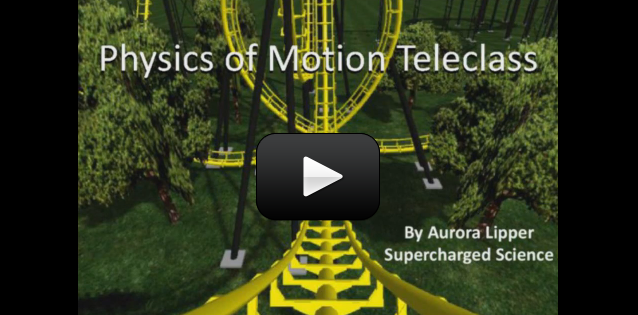This is a recording of a recent live teleclass I did with thousands of kids from all over the world. I’ve included it here so you can participate and learn, too!
We’re going to cover energy and motion by building roller coasters and catapults! Kids build a working catapult while they learn about the physics of projectile motion and storing elastic potential energy. Let’s discover the mysterious forces at work behind the thrill ride of the world’s most monstrous roller coasters, as we twist, turn, loop and corkscrew our way through g-forces, velocity, acceleration, and believe it or not, move through orbital mechanics, like satellites. We’ll also learn how to throw objects across the room in the name of science… called projectile motion. Are you ready for a fast and furious physics class?
Please login or register to read the rest of this content.


This was part of a class where while the kids were working on their projects, I was answering questions about the science program. Since you are already a member, this part has been removed, and then when the students returned we answered a few kids questions and closed the class. The content for the class is complete – so at the end have your students begin the catapults… I hope this helps!
The video just seemed to cut off before being done. Aurora was giving the kids about 6 minutes to build the catapults and said something about the parents staying, then it ends. Is that all it was supposed to be? Seems unfinished.
Oops! I forgot to mention this during class. Here are notes from this part of the class:
Eratosthenes (air-uh-toss-the-knees) was a Greek mathematician, geographer and astronomer. People love his work because he figured out the size of the Earth way before anyone had calculators (240 BC) using the angle of the Sun at noon in two different cities.
Sir Isaac Newton needed the right kind of math to support his new physics ideas, so he invented calculus. He did a number of incredible works in astronomy, physics, math, and much more.
Richard Feynman completely changed the way we teach physics to college students today, he worked on quantum electrodynamics, translated Mayan hieroglyphics. He played the drums, could pick virtually any lock, and sold more than 2 million copies of his physics lectures.
The fifth state of matter was discovered in 1995 by Eric Cornell and Carl Weiman through experimentation with rubidium, but the credit goes to Satyendra (sat-YENdra) Nath Bose and Albert Einstein because they thought of the concept of this state of matter first.
Kids were to write down their favorite scientists that I mentioned in the latter part of the class which I think was cut off from the recording. Sorry about that!
The worksheet has something at the end about 3 scientists but the video ends without the answers to write there. What was that about?
Yes you can find more projects that go with Physics in Units 4 and 5. Have fun!
The video at the end gives a few minutes to the kids to finish their project but is there another video somewhere with maybe the designs that came up ? Good ideas to think about ? Points to consider etc ?
No, stir sticks won’t work because they are too skinny. It is best to use popsicle sticks or tongue depressors.
Can you use stir sticks
Sorry about that – it looks like the page formatting was mixed up. I fixed it and how the worksheet is showing. Have fun!
I’m not finding the fill-in-the-blank worksheet that goes along with the video/lecture. Thx!
Sorry about that – I’ve updated the link!
Hi! the first video says “this video doesn’t exist” should I go to the next lesson and not do “Physics of motion”?
I will have Tonya connect with you right away.
Hi,
This was listed under 3rd grade. Other topics listed under 3rd grade are also unavailable to us. Could you check on this for us. Thank you.